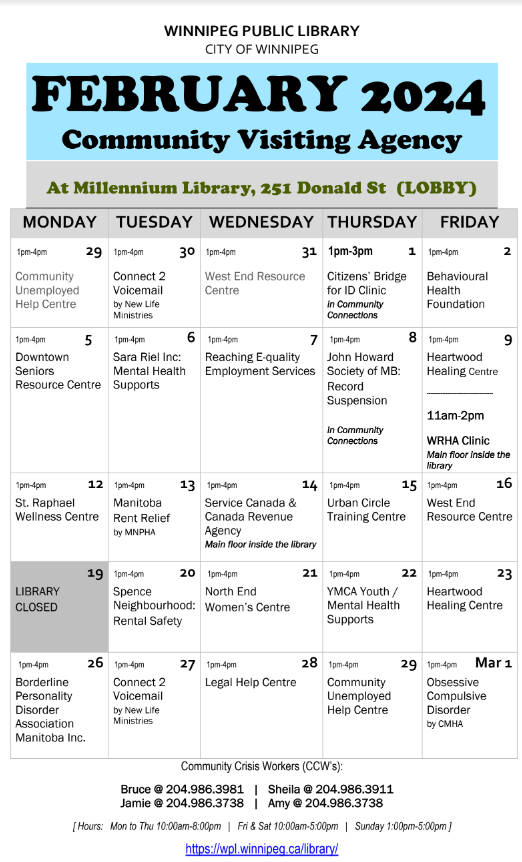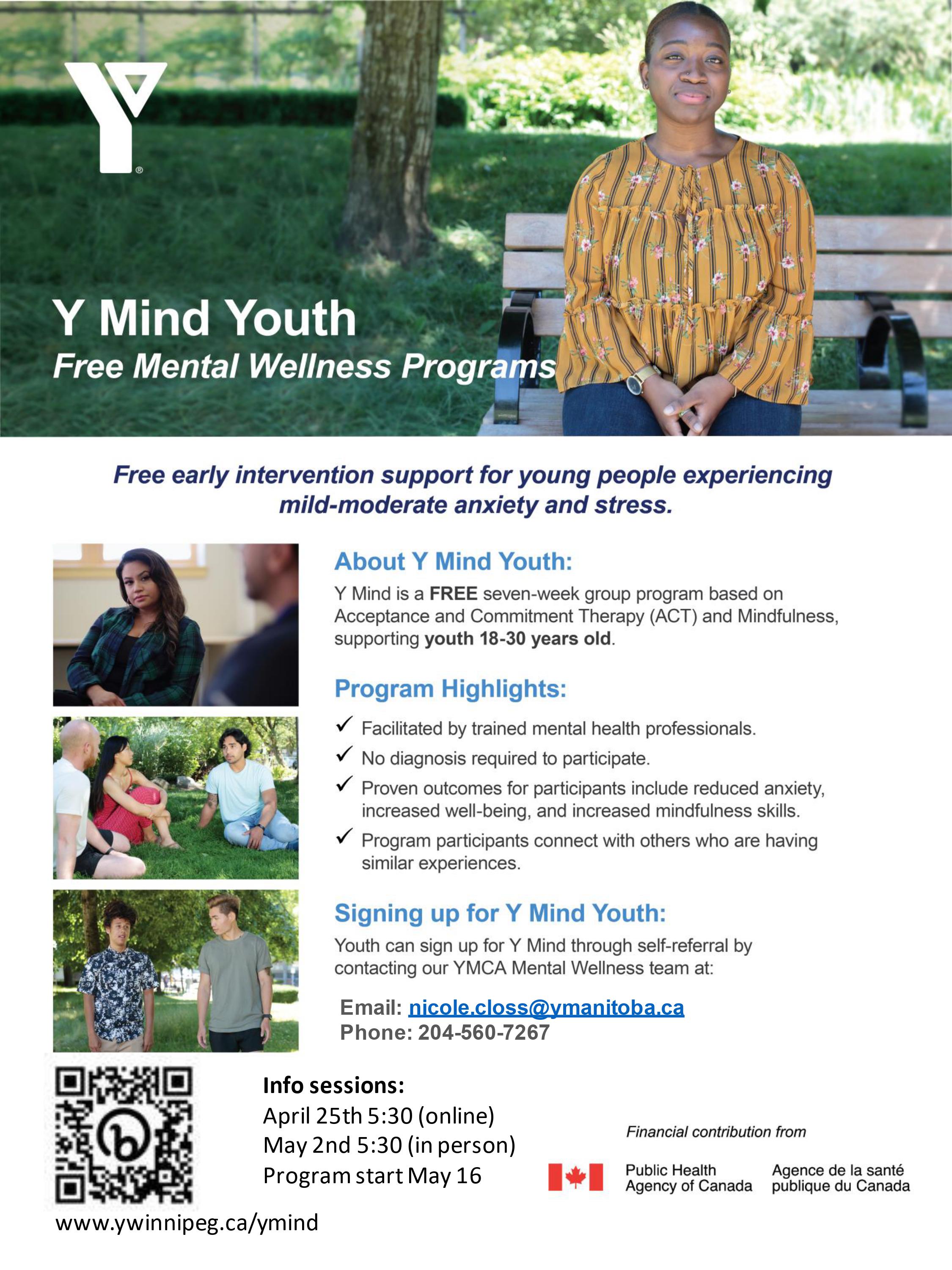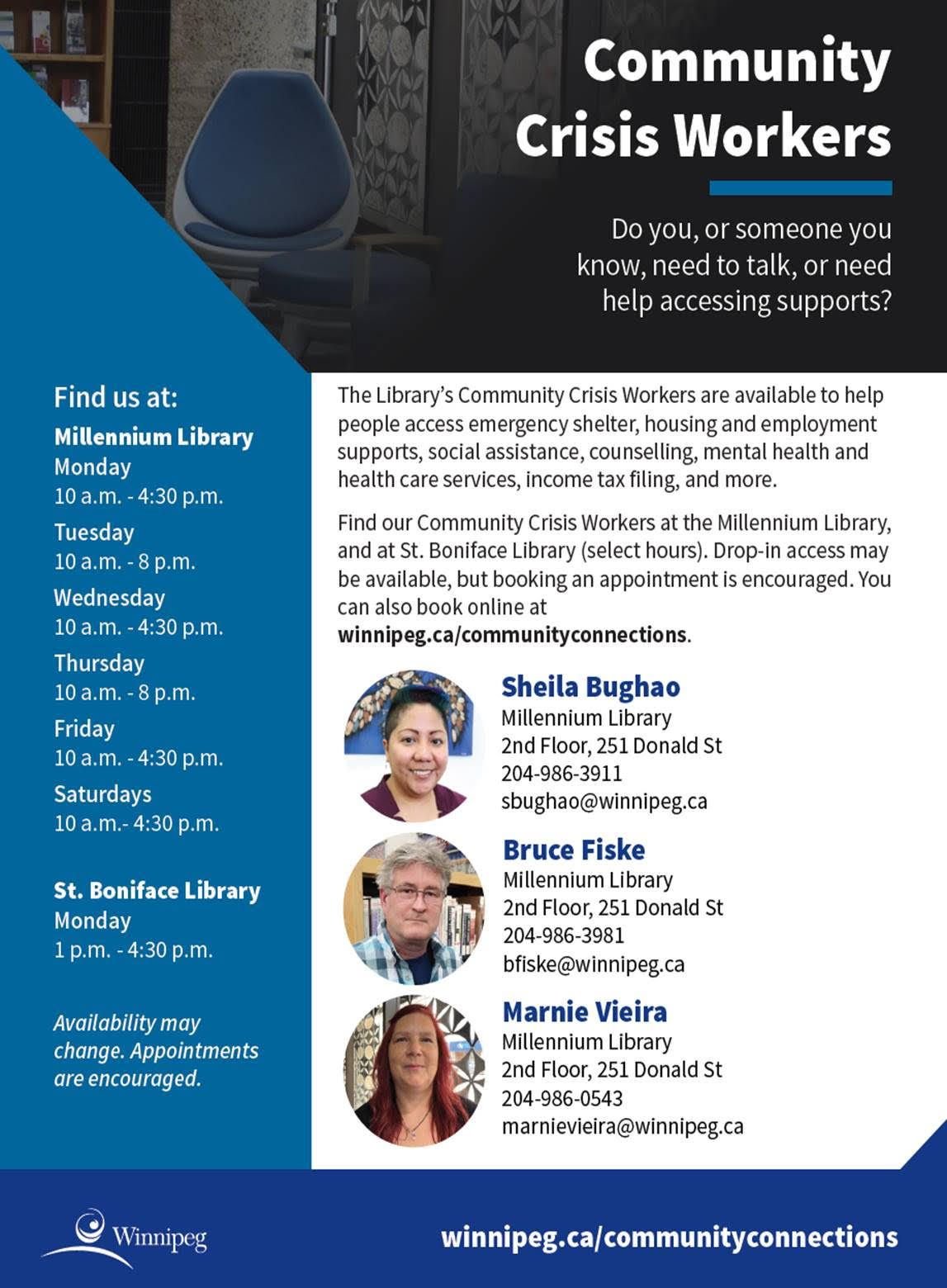Community Visiting Agency Info Booth

Y Mind Youth Free Mental Wellness Programs

Community Crisis Workers

Click this link to book an appointment: https://wpl.winnipeg.ca/library/communityconnections/communitycrisisworkers.stm
Dealing with panic attacks
When panic strikes: some tips for managing panic attacks
- Learn to recognize your early signs of panic. It is easier to manage mild to moderate anxiety than full-blown panic.
- Observe any tension in your body and release it. For example, if your hands are gripping your chair, relax your hands.
- Take a couple of slow breaths through your nose. As you inhale say, “peace, calm, safe.” As you exhale, repeat “letting go of tension and fear.”
- Distract yourself by talking to another person. This will take your mind off your panic symptoms.
- Focus on the present. Look around you; pay attention to your environment and look at: people, cars, colours in a room. It will take your mind away from your anxious thoughts.
- Do something physical to expend energy and adrenaline.
- Don’t fight your panic feelings — accept them and “go with the flow.” Resisting your feelings just makes them worse.
- Use reassuring self-talk.
- “Anxiety is horrible but it isn’t life-threatening.”
- “This isn’t an emergency — this is a panic attack and I know what to do.”
- “These are just my thoughts scaring me — there is nothing dangerous here.”
- “I’m safe.”
- Anger and humour can be effective in reducing anxiety. Speak directly to your fear:
- “Get lost — I don’t have to put up with you.”
- “Chill out.”
- “So what.”
- Create your own statements and use what works for you.
- Pat yourself on the back for helping yourself control the panic. It will get easier as you continue to practice your skills.
Relaxation techniques
Progressive Muscle Relaxation
Easy to learn, easy to do, only takes 15-20 minutes
Helps you feel the difference between relaxed and tense muscles
Calms the body – Reduces physical symptoms
Use as a coping tool
Step 1: Find a comfortable place to sit or lie down where you will not be disturbed.
Step 2: Close your eyes.
Step 3: Tense each muscle group for about 5 seconds, then relax for 10-20 seconds. Tense and relax each muscle group two times, in the order below. Do not tense your muscles so hard that they hurt, and tense only lightly if you have an injury in that muscle area.
Clench your left fist; relax.
Clench your right fist; relax.
Bend both hands back at the wrist to tense forearm muscles; relax.
Clench both fists, bend your arms and lift your hands toward your shoulders, tensing the muscles of your upper arms; relax.
Pull your shoulders up toward your ears; relax.
Wrinkle your forehead and brow; relax.
Close your eyes tightly; relax. (be cautious if wearing contact lenses).
Clench your teeth and jaw muscles; relax.
Press your lips together; relax.
Bring your head forward and pull your chin in toward your chest; relax.
Arch your back and stick out your chest and abdomen; relax.
Take a deep breath, filling your lungs completely, and hold it for 5 seconds; exhale and relax.
Tighten the muscles in your abdomen; relax.
Tighten the muscles in your lower back and buttocks; relax.
Stretch both legs out in front of you, pointing your toes; relax.
Tighten the muscles along your shins by flexing your feet and pointing your toes up toward the ceiling; relax.
Step 4: After you have tensed and relaxed all the muscle groups, sit quietly for a few minutes with your eyes closed.
Step 5: Practice relaxed breathing for a few minutes. Count back from 5 slowly, and transfer your awareness to your surroundings. Open your eyes. You should feel awake and relaxed. And remember, practice each day to get the most benefit.
ADAM. CALM or Diaphragmatic Breathing, 2007
CALM or Diaphragmatic Breathing
Sit on a comfortable chair; put your feet on the floor.
Close your mouth and breathe through your nose.
Breathe in slowly, pushing your stomach out.
Hold a few seconds.
Breathe out slowly.
As you exhale use a silent word: “calm” or “peace” or “safe.”
Repeat for 2 minutes; then extend to 5-10 minutes.
Practice every day. Practice when you're already relaxed. Practice, practice, practice, and it will become second nature in times of strain.
Coping with anxiety: techniques and tidbits
Coping with Anxiety
A certain amount of anxiety in life is inevitable – the key is to learn to deal with our fears in a healthy manner.
Education
Learn about anxiety disorders & treatment options by consulting different resources:
Self-Help Books
Community mental health organizations
Family doctor
Reliable internet sources (i.e. HYPERLINK "http://www.adam.mb.ca/" \t "_blank" www.adam.mb.ca & its related links)
Someone else who has struggled with an anxiety disorder and found the help they need
Social worker
Trusted family members/friends
Relaxation
Take time for Fun (activities that don’t involve anxiety)
Soothe the Soul (what does your body & heart want)
Learn Specific Relaxation Techniques
Progressive Muscle Relaxation (Calm CD)
Paced Breathing (Calm CD)
Visualization
Recognize Automatic Negative Thinking
Catastrophizing
If I leave the heater on - it’ll start a fire – the house will burn down - my dog will die in horrible pain – I won’t be able to live with myself
All or Nothing
If I can’t do it perfectly - I won’t do it at all
Personalizing
My co-worker is upset – I must have done something wrong
Overgeneralizing
I never understand anything at school
Negative Mental Filter
Pessimism – the glass is always half empty
“Should” statements – guilting / self-blame
I should have been more careful
Think Realistically
Re-evaluate Risk
What’s the worst thing that could possibly happen?
How many times have I predicted this outcome and how often has it actually happened?
Has this ever happened to anyone I know?
Would I agree with similar predictions if they were made by someone else?
Use Coping Thoughts
I feel nervous, but that’s OK.
My heart is beating fast, but that won’t hurt me.
Not everyone has to like me.
It’s OK to be human.
I can cope with disapproval – it’s not that bad.
Recognize Maladaptive Coping Patterns
Avoidance
Making excuses (illness, previous commitment)
Hiding / Sleeping
Not answering/returning calls
Arriving late and leaving early
Drugs / Alcohol (“just enough to take the edge off”)
Smoking
Television
Video Games
Expose Yourself to Fearful Situations
Face Fears one step at a time (gradually increase in difficulty)
Set goals (small to large)
Small: phone a friend
Medium: go for coffee with a friend
Large: go out for supper with a group of friends
Repeat new behaviors frequently and regularly
Coping With Stress
- Nutrition and rest … are basic components of overall health
- Talk it out … talking over your worries with someone you trust can relieve tension and help bring problems into perspective
- Walk it out … a brisk walk and other physical activities are proven ways to work off tension and increase well-being
- Pay attention to your thoughts – avoid negative, limiting thoughts like …"this will never get better"… put-downs to yourself “I’m a loser” … create realistic messages about your abilities
- Clarify your values and purpose in life ... build your world around these
- Simplify, simplify, simplify ... too many possessions and too much activity can overwhelm … get rid of unwanted and/or unnecessary items and activities
- Time management … can be learned if that is a problem for you
- Make time for leisure, laughter … all work and no play is not healthy
- Pace yourself … do one thing at a time…do the less pleasant tasks first … take breaks
- Say “no” to some requests ... remind yourself that you are not the general manager of the universe
- Relax your standards … ask yourself the question ”Am I human?” … realize you (and others) are not perfect and can make mistakes … do your best and leave the rest
- Avoid basement people … people who drag you down … hang around positive friends
- Let go … of resentment, jealousy, distrust … they will drain your energy and joy
- Count your blessings ... even if everything seems to be going wrong, there are many things for which to be thankful … count ‘em
- Nurture family & friends … they are anchors in our lives … give as well as take
- Contribute to others … giving of yourself creates a feeling of purpose and accomplishment
- Maintain integrity, honesty, and self-respect ... looking yourself in the mirror at the end of the day and knowing that you’ve done what’s right … brings inner peace and self-respect
- Cultivate spirituality … find ways to renew your soul and spirit
Challenging Negative Thinking
UNHELPFUL THOUGHTS
• “I’m so hopeless!”
• “I’ll never be good at anything!”
• “I must succeed in everything I do!”
• “No one will accept me if I make a mistake.”
• “I will die of embarrassment if I answer the question wrong.”
SELF-CHECK!
• Could you be exaggerating?
• Check it out with a friend.
• Are you sure this is really going to happen?
• Is this really true?
• How much does it matter what other people think?
• Are you forgetting the positives?
• Can you really expect to be perfect at everything you do?
• What is the worst thing that could possibly happen? What is the evidence?
HELPFUL THOUGHTS
• “Everyone is good at different things. This might be something I will have to practice at.”
• “Nobody is a success at everything they do. It’s ok if I am not perfect. Being perfect is boring!”
• “Mistakes are opportunities to learn. It’s okay if I make a mistake. I am human.”
• “No one dies of embarrassment. There are far more embarrassing situations in life. Remember – nobody is perfect!!”
What other unhelpful thoughts do you have? What would be a more realistic way to think of that situation?
Support
Supporting a Friend/Family Member
A friend or family member with an anxiety disorder needs good support in addition to effective treatment. Criteria for effective helpers include: knowledge of anxiety, an understanding of the recovery process, compassion, sensitivity, patience, and strong boundaries. If you are that special person in their life, here are some suggestions.
Helpful Support
1. DO educate yourself about anxiety disorders. A good support is informed.
2. DO let them set the pace for recovery. You may want to take a trip to Hawaii this winter, but it may be more realistic to plan for next year. Follow their agenda.
3. DO ask them what they need from you. When they are anxious, do they need a hug/space/talk or quiet. You can’t assume what they need; they are the expert.
4. DO become familiar with the way they calm them-selves, then you can work together when they are anxious.
5. DO give praise for every achievement, no matter how small. Sitting in a restaurant for 15 minutes may be a big step for someone who has avoided eating in public.
6. DO suggest recording each of their gains. On a discouraging day, they can review their notes and see their progress.
7. DO acknowledge their fear. Reassure them that anxiety feels terrible but isn’t life-threatening.
8. DO allow yourself, at times, to feel resentful, helpless, frustrated or afraid. You have taken on a difficult task.
9. DO give yourself the care you need. Maintain your social supports. Take breaks. Tell them you are needing a time-out and reassure them that you are not abandoning them. By doing so, you are modelling self-care and healthy boundaries.
Unhelpful Support
1. DON’T blame them or yourself for their problems.
2. DON’T minimize their fears. Don’t say "get a grip," "think positive" or "relax."
3. DON’T panic if they panic. Read the literature on controlling anxiety and practice how to manage yours.
4. DON’T pressure them to take bigger steps than for what they are ready. Every little step builds self-confidence.
5. DON’T encourage avoidance. If they panic and leave a situation, allow them time to calm themselves and then suggest gradually returning to the situation.
6. DON’T be domineering and insist they take a particular step. Their ability to choose decreases anxiety and helps them feel in control.
7. DON’T be overprotective. They don’t need a parent, but need to build self-confidence by facing their fears.
8. DON’T rearrange your life to accommodate their recovery. That is not healthy for you or for them.
9. DON’T take on the burden of recovery. You are not responsible for their wellness - only they are.
10. DON’T quit. Persevere. There is effective treatment for anxiety, but time and patience are needed.
